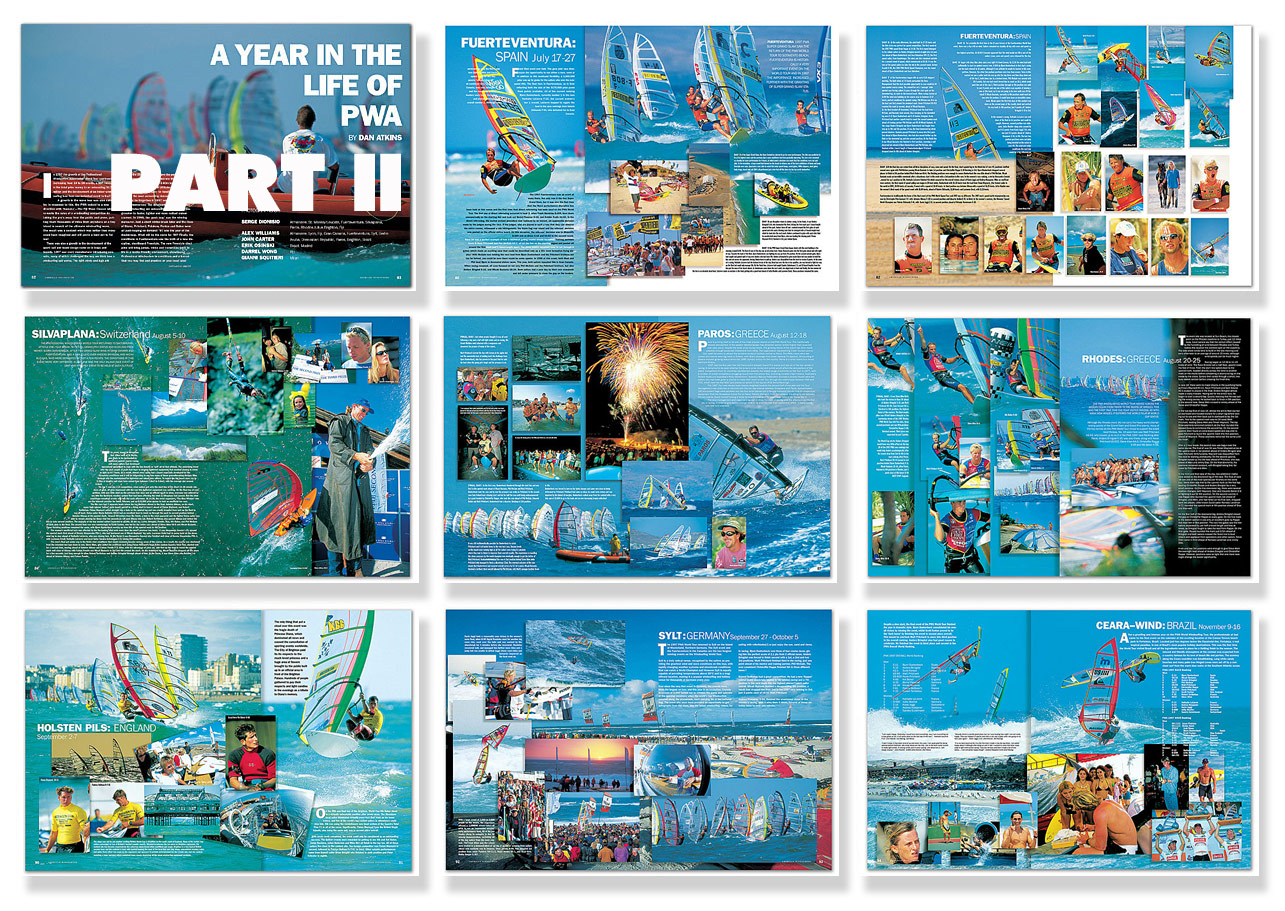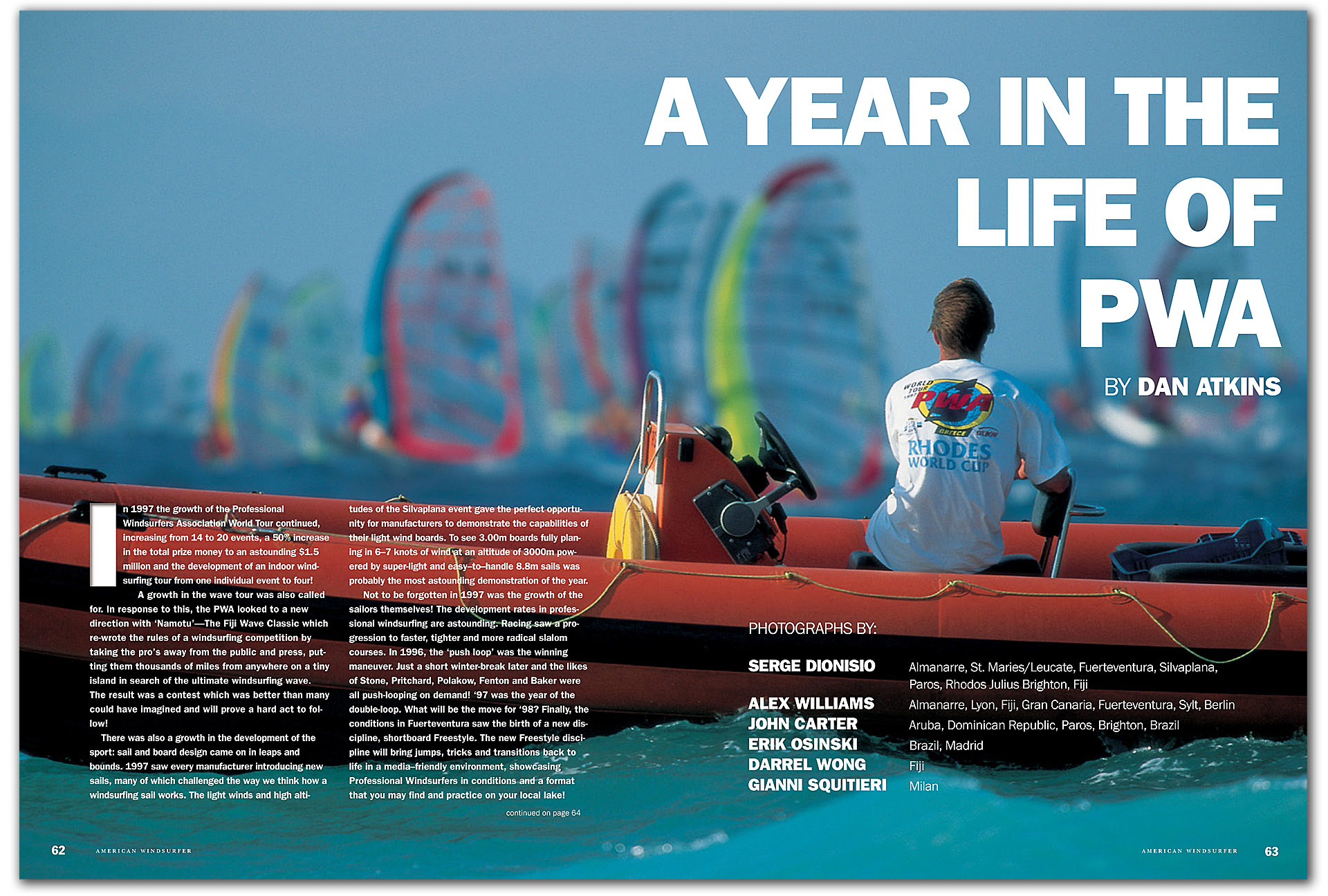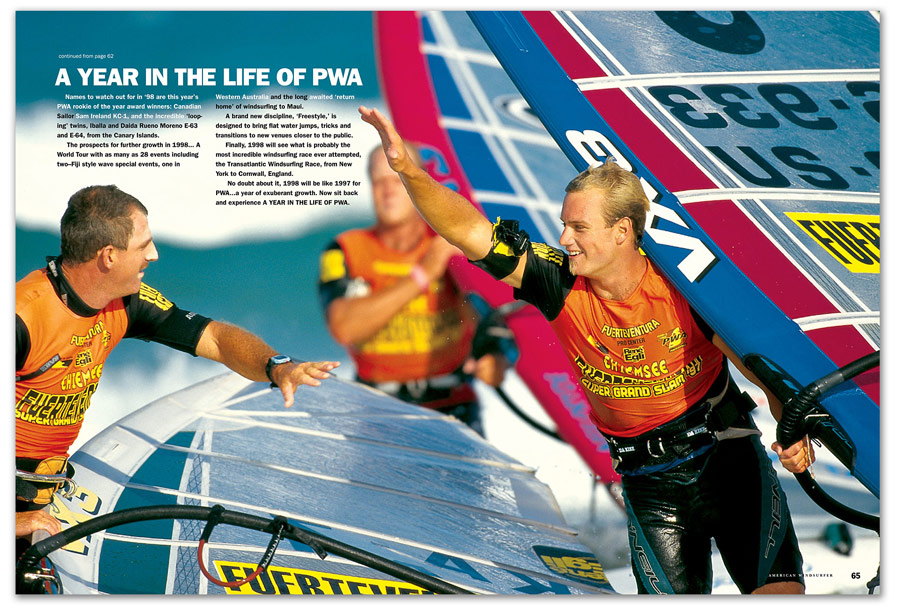
PHOTOGRAPHS BY:
SERGE DIONISIO: Almanarre, St. Maries/Leucate, Fuerteventura, Silvaplana,Paros, Rhodos
JULIUS BRIGHTON: Fiji
ALEX WILLIAMS: Almanarre, Lyon, Fiji, Gran Canaria, Fuerteventura, Sylt, Berlin
JOHN CARTER: Aruba, Dominican Republic, Paros, Brighton, Brazil
ERIK OSINSKI: Brazil, Madrid
DARREL WONG: Fiji
GIANNI SQUITIERI: Milan
IN 1997 THE GROWTH of the Professional Windsurfers Association World Tour continued, increasing from 14 to 20 events, a 50% increase in the total prize money to an astounding $1.5 million and the development of an indoor windsurfing tour from one individual event to four!
A growth in the wave tour was also called for. In response to this, the PWA looked to a new direction with ‘Namotu’—The Fiji Wave Classic which re-wrote the rules of a windsurfing competition by taking the pro’s away from the public and press, putting them thousands of miles from anywhere on a tiny island in search of the ultimate windsurfing wave. The result was a contest which was better than many could have imagined and will prove a hard act to follow!
There was also a growth in the development of the sport: sail and board design came on in leaps and bounds. 1997 saw every manufacturer introducing new sails, many of which challenged the way we think how a windsurfing sail works. The light winds and high altitudes of the Silvaplana event gave the perfect opportunity for manufacturers to demonstrate the capabilities of their light wind boards. To see 3.00m boards fully planing in 6–7 knots of wind at an altitude of 3000m powered by super-light and easy–to–handle 8.8m sails was probably the most astounding demonstration of the year.
Not to be forgotten in 1997 was the growth of the sailors themselves! The development rates in professional windsurfing are astounding. Racing saw a progression to faster, tighter and more radical slalom courses. In 1996, the ‘push loop’ was the winning maneuver. Just a short winter-break later and the likes of Stone, Pritchard, Polakow, Fenton and Baker were all push-looping on demand! ‘97 was the year of the double-loop. What will be the move for ‘98? Finally, the conditions in Fuerteventura saw the birth of a new discipline, shortboard Freestyle. The new Freestyle discipline will bring jumps, tricks and transitions back to life in a media–friendly environment, showcasing Professional Windsurfers in conditions and a format that you may find and practice on your local lake!
Names to watch out for in ‘98 are this year’s PWA rookie of the year award winners: Canadian Sailor Sam Ireland KC-1, and the incredible ‘looping’ twins, Iballa and Daida Rueno Moreno E-63 and E-64, from the Canary Islands.
The prospects for further growth in 1998… A World Tour with as many as 28 events including two–Fiji style wave special events, one in Western Australia and the long awaited ‘return home’ of windsurfing to Maui.
A brand new discipline, ‘Freestyle,’ is designed to bring flat water jumps, tricks and transitions to new venues closer to the public.
Advertisement
Finally, 1998 will see what is probably the most incredible windsurfing race ever attempted, the Transatlantic Windsurfing Race, from New York to Cornwall, England.
No doubt about it, 1998 will be like 1997 for PWA…a year of exuberant growth. Now sit back and experience A YEAR IN THE LIFE OF PWA.
Names to watch out for in ‘98 are this year’s PWA rookie of the year award winners: Canadian Sailor Sam Ireland KC-1, and the incredible ‘looping’ twins, Iballa and Daida Rueno Moreno E-63 and E-64, from the Canary Islands.
The prospects for further growth in 1998… A World Tour with as many as 28 events including two–Fiji style wave special events, one in Western Australia and the long awaited ‘return home’ of windsurfing to Maui.
A brand new discipline, ‘Freestyle,’ is designed to bring flat water jumps, tricks and transitions to new venues closer to the public.
Finally, 1998 will see what is probably the most incredible windsurfing race ever attempted, the Transatlantic Windsurfing Race, from New York to Cornwall, England.
No doubt about it, 1998 will be like 1997 for the PWA… a year of exuberant growth. Now sit back and experience A YEAR IN THE LIFE OF PWA.
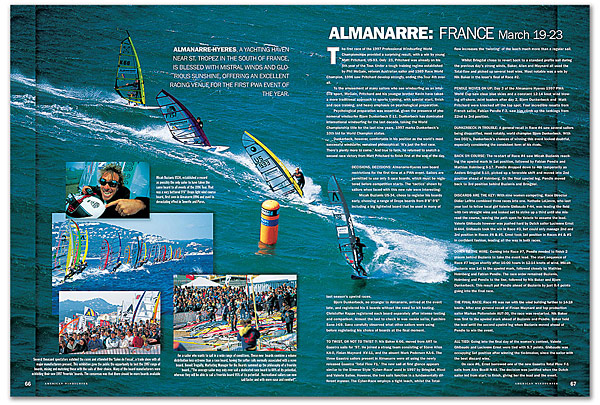
Almanarre-Hyeres, a yachting haven near St. Tropez in the south of France, Is blessed with Mistral winds and glorious sunshine, offering an excellent racing venue for the first PWA event of the Year.
ALMANARRE: FRANCE March 19-23
The first race of the 1997 Professional Windsurfing World Championships provided a surprising result, with a win by young Matt Pritchard, US-93. Only 23, Pritchard was already on his 5th year of the Tour. Under a tough training regime established by Phil McGain, veteran Australian sailor and 1989 Race World Champion, 1996 saw Pritchard develop strongly, ending the Tour 4th overall.
To the amusement of many sailors who see windsurfing as an intuitive sport, McGain, Pritchard and his younger brother Kevin have taken a more traditional approach to sports training, with special start, finish and race training, and heavy emphasis on psychological preparation.
Psychological preparation was essential, given the presence of phenomenal windsurfer Bjorn Dunkerbeck E-11. Dunkerbeck has dominated international windsurfing for the last decade, taking the World Championship title for the last nine years. 1997 marks Dunkerbeck’s 10th bid for World Champion status.
Dunkerbeck, however, comfortable in his position as the world’s most successful windsurfer, remained philosophical: ‘It’s just the first race. There’s plenty more to come.’ And true to form, he returned to snatch a second race victory from Matt Pritchard to finish first at the end of the day.
Advertisement
DECISIONS, DECISIONS: Almanarre-Hyeres saw board restrictions for the first time at a PWA event. Sailors are permitted to use only 5 race boards, which must be registered before competition starts. The ‘tactics’ shown by sailors when faced with this new rule were interesting:
Micah Buzianis US-34, chose to register his boards early, choosing a range of Drops boards from 8’8”-9’6” including a big lightwind board that he used in many of last season’s upwind races.
Bjorn Dunkerbeck, no stranger to Almanarre, arrived at the event late, and registered his 5 boards without the need for kit testing. Christoffer Rappe registered each board separately after intense testing and comparison. Almost the last to check in was rookie sailor, Fumihiro Sano J-69. Sano carefully observed what other sailors were using before registering his choice of boards at the final moment.
TO TWIST, OR NOT TO TWIST ?: Nik Baker K-66, moved from ART to Gaastra sails for ‘97. He joined a strong team consisting of Steve Allen KA-0, Finian Maynard KV-11, and the absent Mark Pedersen KA-6. The three Gaastra sailors present in Almanarre were all using the newly released Gaastra ‘Total Flow F1.’ The new sail at first glance appears similar to the Simmer Style ‘Cyber–Race’ used in 1997 by Bringdal, Ricci and Valerie Salles. However, the two sails function in a fundamentally different manner. The Cyber-Race employs a tight leach, whilst the Total-flow increases the ‘twisting’ of the leach much more than a regular sail.
Whilst Bringdal chose to revert back to a standard profile sail during the previous day’s strong winds, Baker, Allen and Maynard all used the Total-flow and picked up several heat wins. Most notable was a win by Nik Baker in the loser’s final of Race #2.
PENDLE MOVES ON UP: Day 3 of the Almanarre Hyeres 1997 PWA World Cup saw clear blue skies and a constant 12-14 knot wind blowing off-shore. Joint leaders after day 2, Bjorn Dunkerbeck and Matt Pritchard were knocked off the top spot. Four incredible results from French sailor, Fabian Pendle F-3, saw him climb up the rankings from 22nd to 3rd position.
DUNKERBECK IN TROUBLE: A general recall in Race #4 saw several sailors being disqualified, most notably, world champion Bjorn Dunkerbeck. With two DSQ’s, Dunkerbeck’s chances of winning this event looked doubtful, especially considering the consistent form of his rivals.
BACK ON COURSE: The re-start of Race #4 saw Micah Buzianis reaching the upwind mark in 1st position, followed by Fabian Pendle and Mathias Holmberg S-17. Pendle dropped down to 4th temporarily as Anders Bringdal S-10, picked up a favorable shift and moved into 2nd position ahead of Holmberg. On the final upwind leg, Pendle moved back to 3rd position behind Buzianis and Bringdal.
DISCARDS ARE THE KEY: With nine women competing, Race Director Didier Lafitte combined three races into one. Nathalie LeLievre, who last year lost to fellow local girl Valerie Ghibaudo F-44, was leading the field with two straight wins and looked set to strike up a third until she misread the course, leaving the path open for Valerie to assume the lead. Valerie Ghibaudo however was pushed hard by Dutch sailor Lucienne Ernst H-444. Ghibaudo took the win in Race #3, but could only manage 2nd and 3rd position in Races #4 & #5. Ernst took 1st position in Races #4 & #5 in confident fashion, leading all the way in both races.
DOWN TO THE WIRE: Coming into Race #7, Pendle needed to finish 2 places behind Buzianis to take the event lead. The start sequence of Race #7 began shortly after 16:00 hours in 12-14 knots of wind. Micah Buzianis was 1st to the upwind mark, followed closely by Mathias Holmberg and Fabian Pendle. The race order remained Buzianis, Holmberg and Pendle to the line, followed by Nik Baker and Bjorn Dunkerbeck. This result put Pendle ahead of Buzianis by just 0.4 points going into the final race.
THE FINAL RACE: Race #8 was run with the wind building further to 14-18 knots. After one general recall of Finian Maynard and top production sailor Markus Poltenstein AUT-30, the race was re-started. Nik Baker was first to the upwind mark ahead of Buzianis and Pendle. Baker held the lead until the second upwind leg when Buzianis moved ahead of Pendle to win the event.
ALL TIED: Going into the final day of the women’s contest, Valerie Ghibaudo and Lucienne Ernst were tied with 5.7 points. Ghibaudo was occupying 1st position after winning the tie-breaker, since the sailor with the best discard wins.
On race #6, Ernst borrowed one of the new Gaastra Total Flow F-1 sails from Alex Boxill N-41. The decision was justified when the Dutch sailor led from start to finish, giving her the lead and the event.
Next Stop: The Fundole Indoor event in Lyon, France.
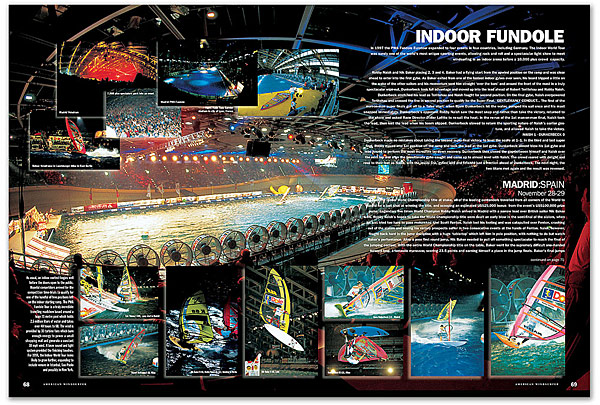
As usual, an indoor contest begins well before the doors open to the public. Hopeful competitors arrived for the competition time-trials to qualify for one of the handful of free positions left on the indoor starting ramp. The PWA Fundole Tour is a truly incredible traveling roadshow based around a huge 70 metre pool which holds 2.5 million liters of water and takes over 40 hours to fill. The wind is provided by 30 turbine fans which burn enough energy to power a small shopping mall and generate a constant 30 mph wind. A laser sound and light system provided the finishing touches. For 1998, the Indoor World Tour looks likely to grow further, expanding to include venues in Istanbul, Sao Paolo and possibly in New York.
LYON, FRANCE: March 27-28
For the first time since the Indoor began 8 years ago, the event did not occur in the Palais D’omnisport at Bercy, Paris but moved instead to the Halle Tony Garnier in the city of Lyon. The stadium was instantly recognizable with its distinctive stepped roof. The relatively low roof of the Lyon stadium made a different arrangement than normal. The Barcelona indoor event in 1996 saw a bigger pool and more powerful fans. The Lyon event saw the same fans with a even bigger pool. The rolling start, debuted in Barcelona also returned. Competitors were given a 15-second countdown, shown on large displays at either end of the pool. Prior to the start, 5 red lights were illuminated and 1 was extinguished each second prior to the start. Competitors left the beach at any time they wished during the 15-second start sequence.
MILAN: ITALY October 17-18
The Milan indoor saw the return of the starting ramp, the infamous 4 gate starting system which released the sailors down a roller-ramp into the water at staggered intervals. The highest seeded sailor took the furthest downwind position on the ramp and was released a fraction of a second ahead of the second seeded sailor etc. This meant that if all four sailors have a perfect start, they would all meet at the first mark at the same time and the sailor in ‘pole position’ would have the inside line on the gybe. To allocate the positions on the starting ramp, the 16 men and 8 women who were qualified for the show performed a timing test in the pool. The outcome of this time-trial saw Nik Baker K-66 placed as no.1 seed ahead of Robby Naish US-1111, Eduardo Bellini E-9, and Anders Bringdal S-10. Anders Bringdal, not normally an indoor specialist, was really flying in practice, using a new Simmer Style indoor sail and RRD indoor custom.
BERLIN: GERMANY October 31-Nov. 1
This is the first time that an indoor event had been held in Berlin but more importantly, the first time that the PWA Fundole Eurotour had brought an event to Germany. The 2.5 million liters of water, the 30 turbine fans and the 70 x 30 metre pool were transported from Milan, to the Velodrome in Landsberger Allee in East Berlin. The brand new stadium was built almost completely underground, with only a few steps visible at ground level! Britain’s Nik Baker led the indoor rankings with a slim lead over Robby Naish. In the women’s indoor rankings, Nathalie LeLievre led both the jump and race categories. Big stars from the outdoor rankings were also sailing in Berlin. World Champion Bjorn Dunkerbeck arrived to compete in a country where Nutella TV advertising made him a household name. Bjorn arrived in Berlin with new indoor boards and new indoor sails and quickly dispelled all myths about heavy sailors being uncompetitive in the indoor arena.
Change in format: There was a slight change in the competition format here in Berlin. The 4 sailors who progressed to the 4 man final had to undergo a second timing trial, in front of the crowd, to decide upon their seeding position on the ramp. First to go was Bjorn Dunkerbeck, who showed his capacity by setting a time of 36 seconds. Next to go was Robert Teriitehau F-35, with a time of 36.61 seconds followed by Robby Naish, who set the fastest trial test until he dropped in on the last gybe, scoring a time of 36.83 seconds, including the fall. Nik Baker K-66 was faster still than Robby around the course but also blew his last gybe and finished with 38 seconds. The four-man final saw Bjorn Dunkerbeck starting from pole position with Robert Teriitehau, Robby Naish and Nik Baker placing 2, 3 and 4. Baker had a flying start from the upwind position on the ramp and was clear ahead to enter into the first gybe. As Baker exited from one of the fastest indoor gybes ever seen, his board tripped a little on the wake of the other sailors and his momentum sent him straight ‘over the bars’ and around the front of the mast in a truly spectacular wipe-out. Dunkerbeck took full advantage and moved up into the lead ahead of Robert Teriitehau and Robby Naish. Dunkerbeck stretched his lead as Teriitehau and Naish fought for second position. On the final gybe, Naish overpowered Teriitehau and crossed the line in second position to qualify for the Super Final. Gentlemanly conduct… The first of the man-on-man super finals got off to a ‘false start’ when Bjorn Dunkerbeck hit the water, pumped his sail once and his mast snapped immediately. Dunkerbeck’s opponent Robby Naish saw the mast snap and rather than take the victory, returned to the shore and asked Race Director Didier Lafitte to re-sail the heat. In the re-run of the 1st man-on-man final, Naish took the lead, then lost the lead when his boom slipped. Dunkerbeck slowed to return the sporting nature of Naish’s earlier gesture, and allowed Naish to take the victory.
Naish 1 – Dunkerbeck 0
Dunkerbeck made no mistakes about taking the second super-final victory, to level the score at 1–1. In the third and last super final, Robby moved into 1st position off the ramp and took the lead at the 1st gybe. Dunkerbeck almost blew his 1st gybe and was forced to perform the most incredible lay-down recovery. Dunkerbeck then closed the gap between himself and Naish over the next lap and after the penultimate gybe caught and came up to almost level with Naish. The crowd roared with delight and rose to their feet as Naish, with the inside line, gybed well and finished just a fraction ahead of Dunkerbeck. The next night, the two titans met again and the result was reversed.
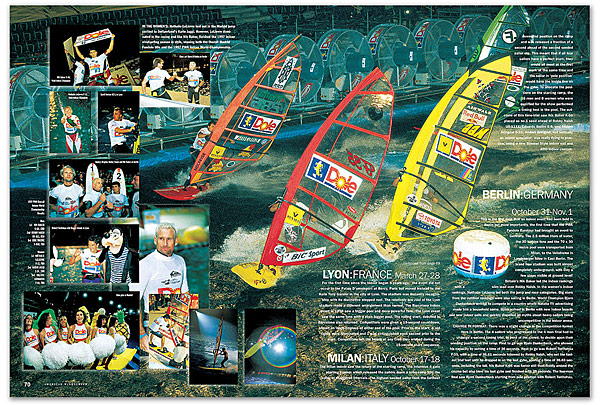
MADRID: SPAIN November 28-29
With the Indoor World Championship title at stake, all of the leading contenders travelled from all corners of the World to Madrid for a last shot at winning the title, and scooping an estimated US$25,000 bonus from the event’s US$100,000 prize purse. Legendary five times World Champion Robby Naish arrived in Madrid with a narrow lead over British sailor Nik Baker K-66. Robby Naish’s hopes to take the World Championship title were dealt an early blow in the semi-final of the slalom, when he just tried too hard to pass mohawked Kiwi Scott Fenton. Naish lost his footing and was catapulted over Fenton, crashing out of the slalom and seeing his victory prospects suffer in two consecutive events at the hands of Fenton. Naish, however, fought back hard in the jump discipline with a huge ‘table-top’ which left him in pole position, with nothing to do but watch Baker’s performance. After a poor first round jump, Nik Baker needed to pull off something spectacular to reach the final of the jumping contest. With the entire World Championship title on the table, Baker went for the supremely difficult one–handed forward loop, a fantastic maneuver, scoring 23.5 points and earning himself a place in the jump finals. Baker’s final jumps improved further and he finished the jump contest just behind France’s Eric Thieme but—more importantly—ahead of Naish. Thieme was in great form, performing near-perfect forward loops and landing dry! Baker went from strength to strength, winning in the slalom super–final duel against Robert Teriitehau. He firmly wrapped up the US$100,000 Overall Madrid Event title, pushing the Frenchman back to 3rd position behind National hero Eduardo Bellini E-9, who performed well all weekend. The Overall Event win was the icing on the cake for Nik Baker, sealing his victory in the 1997 PWA Indoor World Championship and finishing what has been an incredible come-back year after an injury-fraught 1996.
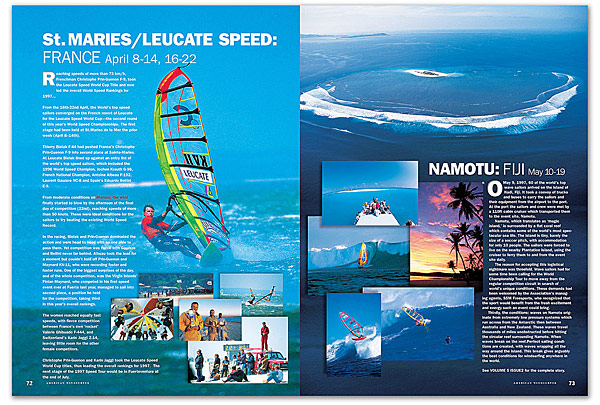
St. MARIES / LEUCATE SPEED: FRANCE April 8-14, 16-22
REACHING SPEEDS OF MORE than 73 km/h, Frenchman Christophe Prin-Guenon F-9, took the Leucate Speed World Cup Title and now led the overall World Speed Rankings for 1997…
From the 16th-22nd April, the World’s top speed sailors converged on the French resort of Leucate for the Leucate Speed World Cup—the second round of this year’s World Speed Championships. The first stage had been held at St.Maries de la Mer the prior week (April 8–14th).
Thierry Bielak F-44 had pushed France’s Christophe Prin-Guenon F-9 into second place at Sainte-Maries. At Leucate Bielak lined up against an entry list of the world’s top speed sailors, which included the 1996 World Speed Champion, Jochen Krauth G-96, French National Champion, Antoine Albeau F-192, Laurent Gauzere NC-8 and Spain’s Eduardo Bellini E-9.
From moderate conditions on Monday, the wind finally started to blow by the afternoon of the final day of competition (22nd), reaching speeds of more than 50 knots. These were ideal conditions for the sailors to try beating the existing World Speed Record.
In the racing, Bielak and Prin-Guenon dominated the action and were head to head with no one able to pass them. Yet competition was fierce with Gauzere and Bellini never far behind. Albeau took the lead for a moment but couldn’t hold off Prin-Guenon and Maynard KV-11, who were recording faster and faster runs. One of the biggest surprises of the day, and of the whole competition, was the Virgin Islands’ Finian Maynard, who competed in his first speed event ever at Fuerte last year, managed to sail into second place, a position he held for the competition, taking third in this year’s overall rankings.
The women reached equally fast speeds, with fierce competition between France’s own ‘rocket’ Valerie Ghibuado F-444, and Switzerland’s Karin Jaggi Z-14, leaving little room for the other female competitors.
Christophe Prin-Guenon and Karin Jaggi took the Leucate Speed World Cup titles, thus leading the overall rankings for 1997. The next stage of the 1997 Speed Tour would be in Fuerteventura at the end of July.
NAMOTU: FIJI MAY 10-199
On May 9, 1997, 60 of the world’s top wave sailors arrived on the island of Nadi, Fiji. It took a convoy of trucks and buses to carry the sailors and their equipment from the airport to the port. At the port the sailors and crew were met by a 110ft cabin cruiser which transported them to the event site, Namotu.
Namotu, which translates as ‘magic island,’ is surrounded by a flat coral reef which contains some of the world’s most spectacular sea life. The island is tiny, barely the size of a soccer pitch, with accommodation for only 10 people. The sailors were forced to live on the nearby Plantation Island, using the cruiser to ferry them to and from the event site daily.
The reason for accepting this logistical nightmare was threefold. Wave sailors had for some time been calling for the World Championship Tour to move away from the regular competition circuit in search of world’s unique conditions. These demands had been welcomed by the Association’s managing agents, SSM Freesports, who recognized that the sport would benefit from the fresh excitement and energy such an event could bring.
Thirdly, the conditions: waves on Namotu originate from extremely low pressure systems which run across from the Antarctic then between Australia and New Zealand. These waves travel thousands of miles unobstructed before hitting the circular reef surrounding Namotu. When waves break on the reef.Perfect sailing conditions are created, with waves wrapping all the way around the island. This break gives arguably the best conditions for windsurfing anywhere in the world.
See here: Volume 5 Issue2 for the complete story.
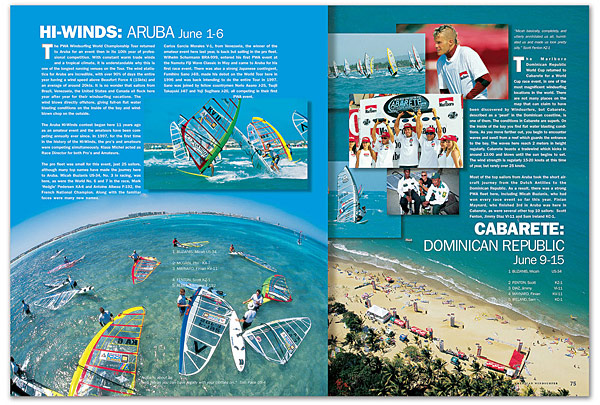
HI-WINDS, ARUBA: June 1-6
The PWA Windsurfing World Championship Tour returned to Aruba for an event then in its 10th year of professional competition. With constant warm trade winds and a tropical climate, it is understandable why this is one of the longest running venues on the Tour. The wind statistics for Aruba are incredible, with over 90% of days the entire year having a wind speed above Beaufort Force 4 (15kts) and an average of around 20kts. It is no wonder that sailors from Brazil, Venezuela, the United States and Canada all flock here year after year for their windsurfing vacations. The wind blows directly offshore, giving full-on flat water blasting conditions on the inside of the bay and wind-blown chop on the outside.
The Aruba Hi-Winds contest began here 11 years ago as an amateur event and the amateurs have been competing annually ever since. In 1997, for the first time in the history of the Hi-Winds, the pro’s and amateurs were competing simultaneously. Klaus Michel acted as Race Director for both Pro’s and Amateurs.
The pro fleet was small for this event, just 25 sailors, although many top names have made the journey here to Aruba. Micah Buzianis US-34, No. 3 in racing, was here, as were the World No. 6 and 7 in the race, Mark ‘Hedgie’ Pedersen KA-6 and Antoine Albeau F-192, the French National Champion. Along with the familiar faces were many new names. Carlos Garcia Morales V–1, from Venezuela, the winner of the amateur event here last year, is back but sailing in the pro fleet. Wilhelm Schurmann BRA-999, entered his first PWA event at the Namotu Fiji Wave Classic in May and came to Aruba for his first race event. There was also a strong Japanese contingent, Fumihiro Sano J-69, made his debut on the World Tour here in 1996 and was back intending to do the entire Tour in 1997. Sano was joined by fellow countrymen Norio Asano J-25, Tsujii Takayuki J-87 and Yuji Sugihara J–20, all competing in their first PWA event.
CABARETE: DOMINICAN REPUBLIC June 9-15
The Marlboro Dominican Republic World Cup returned to Cabarete for a World Cup race event, in one of the most magnificent windsurfing locations in the world. There are not many places on the map that can claim to have been discovered by Windsurfers, but Cabarete, described as a ‘pearl’ in the Dominican coastline, is one of them. The conditions in Cabarete are superb. On the inside of the bay you find flat water blasting conditions. As you move farther out, you begin to encounter waves and swell from a reef which guards the entrance to the bay. The waves here reach 2 meters in height regularly. Cabarete boasts a tradewind which kicks in around 13:00 and blows until the sun begins to set. The wind strength is regularly 15-20 knots at this time of year, but rarely over 25 knots.
Most of the top sailors from Aruba took the short aircraft journey from the Dutch Antilles to the Dominican Republic. As a result, there was a strong PWA fleet here, including Micah Buzianis, who had won every race event so far this year. Finian Maynard, who finished 3rd in Aruba was here in Cabarete, as were several other top 10 sailors: Scott Fenton, Jimmy Diaz VI-11 and Sam Ireland KC-1.
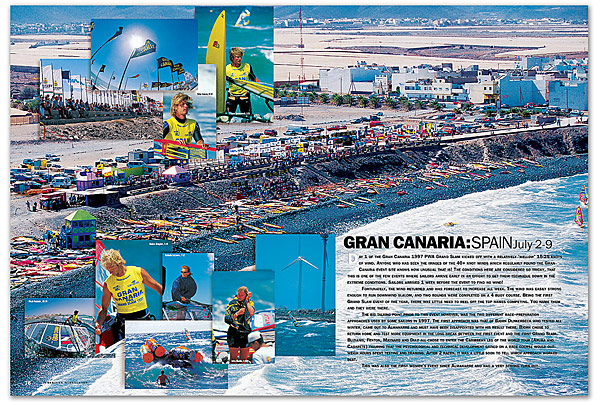
GRAN CANARIA: SPAIN July 2-9
Day 1 of the Gran Canaria 1997 PWA Grand Slam kicked off with a relatively ‘mellow’ 15-25 knots of wind. Anyone who has seen the images of the 40+ knot winds which regularly pound the Gran Canaria event site knows how unusual that is! The conditions here are considered so tricky, that this is one of the few events where sailors arrive early in an effort to get their technique down in the extreme conditions. Sailors arrived 1 week before the event to find no wind!
Fortunately, the wind returned and was forecast to increase all week. The wind was easily strong enough to run downwind slalom, and two rounds were completed on a 4 buoy course. Being the first Grand Slam event of the year, there was little need to reel off the top names competing. You name them and they were there.
The big talking point prior to this event however, was the two different race–preparation approaches used by some sailors in 1997. The first approach was that of Bjorn Dunkerbeck who tested all winter, came out to Almanarre and must have been disappointed with his result there. Bjorn chose to return home and test more equipment in the long break between the first event and the first Grand Slam. Buzianis, Fenton, Maynard and Diaz all chose to enter the Caribbean leg of the world tour (Aruba and Cabarete) figuring that the psychological and technical development gained on a race course would outweigh hours spent testing and training. After 2 races, it was a little soon to tell which approach worked best.
This was also the first women’s event since Almanarre and had a very strong turn out.
GRAND CANARIA: Spain
On waves, Matt Pritchard sailed well, eliminating Erik Thieme and Bernd Flessner before meeting Robby Naish for a repeat of their duel in the first round. Naish emerged the victor again after out-scoring Matt in the wave-riding category. Bjorn Dunkerbeck progressed two further rounds from the first elimination to meet Robby Naish and challenge for third position. Dunkerbeck very nearly did not progress at all after uncharacteristically ‘bailing’ from an aborted back-loop and losing his equipment, which was swept 75m onto the beach. Dunkerbeck managed not only to recover his equipment but to beat back out into the competition area and win the heat!
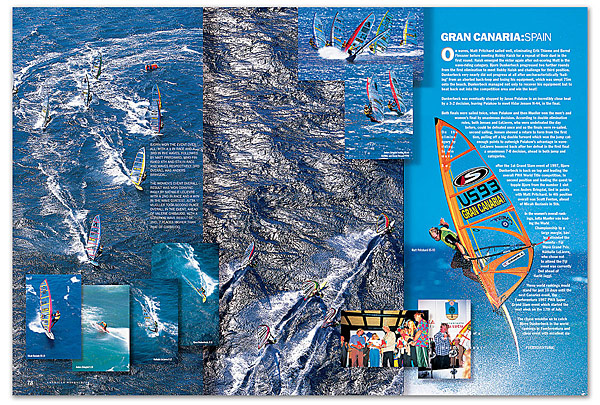
Bjorn won the event overall, with a #1 in race and a 3rd in the waves, followed by Matt Pritchard, who finished 4th and 5th in race and waves respectively. 3rd overall was Anders Bringdal.
The women’s event overall result was won convincingly by Nathalie LeLievre with a 2nd in Race and a win in the wave contest. Jutta Mueller took second place overall in the event, ahead of Valerie Ghibaudo, with a superior wave result of 2nd, 7 places higher than that of Ghibaudo.
Dunkerbeck was eventually stopped by Jason Polakow in an incredibly close heat by a 3-2 decision, leaving Polakow to meet Vidar Jensen N-44, in the final.
Both finals were sailed twice, when Polakow and then Mueller won the men’s and women’s final by unanimous decision. According to double elimination rules, both Jensen and LeLievre, who were undefeated the day before, could be defeated once and so the finals were re-sailed. On the second sailing, Jensen showed a return to form from the first elimination, pulling off a big double forward which won the jump category by enough points to outweigh Polakow’s advantage in wave-riding. LeLievre bounced back after her defeat in the first final to win a unanimous 7-0 decision, ahead in both jump and wave categories.
So, after the 1st Grand Slam event of 1997, Bjorn Dunkerbeck is back on top and leading the overall PWA World Title competition. In second position and leading the quest to topple Bjorn from the number 1 slot was Anders Bringdal, tied in points with Matt Pritchard. In 4th position overall was Scott Fenton, ahead of Micah Buzianis in 5th.
In the women’s overall rankings, Jutta Mueller was leading the World Championship by a large margin, having attended the Namotu – Fiji Wave Grand Prix. Nathalie LeLievre, who chose not
to attend the Fiji event was currently 2nd ahead of
Karin Jaggi.
These world rankings would stand for just 10 days until the next Canaries event, the Fuerteventura 1997 PWA Super Grand Slam event which started the next week on the 17th of July.
The chase wouldbe on to catch Bjorn Dunkerbeck in the world rankings in Fuerteventura and we were assured of a close event with excellent slalom conditions.
Next Stop: FUERTEVENTURA!
Continue to Part II
